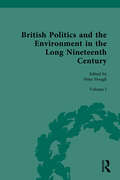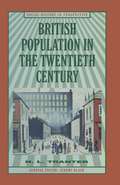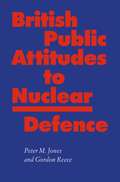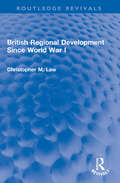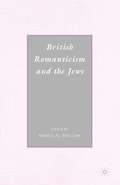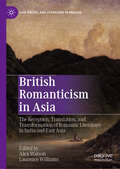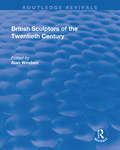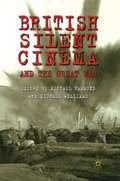- Table View
- List View
British Policy in Persia, 1918-1925
by Houshang SabahiFirst Published in 1990. Routledge is an imprint of Taylor & Francis, an informa company.
British Policy Towards the Ottoman Empire 1908-1914
by Joseph HellerFirst Published in 2004. Routledge is an imprint of Taylor & Francis, an informa company.
British Policy Towards the Ottoman Empire 1908-1914
by Joseph HellerFirst Published in 2004. Routledge is an imprint of Taylor & Francis, an informa company.
British Politics and the Environment in the Long Nineteenth Century: Volume I - Discovering Nature and Romanticizing Nature
by Peter HoughThis volume of archival source material chronicles British environmental politics between 1789 and 1914. This text examines scientific discoveries during this period and the result of these findings on the political environment, bringing the public's attention to public health issues such as acid rain and river pollution. Accompanied by extensive editorial commentary, this collection will be of great interest to students of environmental and political history.
British Politics and the Environment in the Long Nineteenth Century: Volume I - Discovering Nature and Romanticizing Nature
by Peter HoughThis volume of archival source material chronicles British environmental politics between 1789 and 1914. This text examines scientific discoveries during this period and the result of these findings on the political environment, bringing the public's attention to public health issues such as acid rain and river pollution. Accompanied by extensive editorial commentary, this collection will be of great interest to students of environmental and political history.
The British Pop Music Film: The Beatles and Beyond
by S. GlynnThe first detailed examination of the place of pop music film in British cinema, Stephen Glynn explores the interpenetration of music and cinema in an economic, social and aesthetic context through case studies ranging from Cliff Richard to The Rolling Stones, and from The Beatles to Plan B.
British Population in the Twentieth Century (Social History in Perspective)
by N.L. TranterOne of the most striking features of the demography of twentieth century Britain and its constituent countries has been the persistence of rates of population growth far lower than those of the nineteenth century. By the 1980s even the absolute size of the population had begun to decline. Why has this happened? And why have falling rates of population growth been accompanied by equally dramatic changes in the geography of human residence? In an attempt to answer these questions, the book traces the evolution of trends in levels of fertility, mortality and migration and considers the nature of the forces responsible for these trends.
British Pronoun Use, Prescription, and Processing: Linguistic and Social Influences Affecting 'They' and 'He'
by L. PatersonThis study considers the use of they and he for generic reference in post-2000 written British English. The analysis is framed by a consideration of language-internal factors, such as syntactic agreement, and language-external factors, which include traditional grammatical prescriptivism and the language reforms resulting from second-wave feminism.
British Public Attitudes to Nuclear Defence
by Peter Jones Gordon ReeceThe aim of this book is to inform debate both within political parties and amongst those interested in British defence policy by supplying data on British public attitudes towards nuclear weapons. The survey was undertaken in August 1987 and about 2400 respondents were interviewed.
The British Raj: Keywords
by Pramod K. NayarFor two hundred years India was the jewel in the British imperial crown. During the course of governing India – the Raj – a number of words came to have particular meanings in the imperial lexicon. This book documents the words and terms that the British used to describe, define, understand and judge the subcontinent. It offers insight into the cultures of the Raj through a sampling of its various terms, concepts and nomenclature, and utilizes critical commentaries on specific domains to illuminate not only the linguistic meaning of a word but its cultural and political nuances. This fascinating book also provides literary and cultural texts from the colonial canon where these Anglo-Indian colloquialisms, terms and official jargon occurred. It enables us to glean a sense of the Empire’s linguistic and cultural tensions, negotiations and adaptations. The work will interest students and researchers of history, language and literature, colonialism, cultural studies, imperialism and the British Raj, and South Asian studies.
The British Raj: Keywords
by Pramod K. NayarFor two hundred years India was the jewel in the British imperial crown. During the course of governing India – the Raj – a number of words came to have particular meanings in the imperial lexicon. This book documents the words and terms that the British used to describe, define, understand and judge the subcontinent. It offers insight into the cultures of the Raj through a sampling of its various terms, concepts and nomenclature, and utilizes critical commentaries on specific domains to illuminate not only the linguistic meaning of a word but its cultural and political nuances. This fascinating book also provides literary and cultural texts from the colonial canon where these Anglo-Indian colloquialisms, terms and official jargon occurred. It enables us to glean a sense of the Empire’s linguistic and cultural tensions, negotiations and adaptations. The work will interest students and researchers of history, language and literature, colonialism, cultural studies, imperialism and the British Raj, and South Asian studies.
British Regional Development Since World War I (Routledge Revivals)
by Christopher M. LawFirst published in 1981, British Regional Development Since World War I presents a comprehensive and balanced introduction to the problems of regional development in Britain. Since World War I it has been possible to talk of Britain as two nations, a prosperous South including the Midlands, and a poor North. Christopher Law examines the nature and causes of this division, including impact of industrial structure, London’s role as capital in the spatial economy, and the influence of better environments on development. This valuable study will be an essential read for anyone interested in any aspect of regional development and development studies in the last ninety years.
British Regional Development Since World War I (Routledge Revivals)
by Christopher M. LawFirst published in 1981, British Regional Development Since World War I presents a comprehensive and balanced introduction to the problems of regional development in Britain. Since World War I it has been possible to talk of Britain as two nations, a prosperous South including the Midlands, and a poor North. Christopher Law examines the nature and causes of this division, including impact of industrial structure, London’s role as capital in the spatial economy, and the influence of better environments on development. This valuable study will be an essential read for anyone interested in any aspect of regional development and development studies in the last ninety years.
British Romanticism and the Catholic Question: Religion, History and National Identity, 1778-1829
by M. TomkoThe debate over extending full civil rights to British and Irish Catholics not only preoccupied British politics but also informed the romantic period's most prominent literary works. This book offers the first comprehensive, interdisciplinary study of Catholic Emancipation, one of the romantic period's most contentious issues.
British Romanticism and the Jews: History, Culture, Literature
by S. SpectorBritish Romanticism and the Jews explores the mutual influences exerted by the British-Christian and British-Jewish communities on each other during the period between the Enlightenment and Victorianism. The essays in the volume demonstrate how the texts produced by the Jewish Enlightenment provided a significant resource for romantic intellectual revisionism, in much the same way that British romanticism provided the cultural basis through which the British-Jewish community was able to negotiate between the competing obligations to ethnicity and nationalism.
British Romanticism in Asia: The Reception, Translation, and Transformation of Romantic Literature in India and East Asia (Asia-Pacific and Literature in English)
by Alex Watson Laurence WilliamsThis book examines the reception of British Romanticism in India and East Asia (including China, Japan, Korea and Taiwan). Building on recent scholarship on “Global Romanticism”, it develops a reciprocal, cross-cultural model of scholarship, in which “Asian Romanticism” is recognized as itself an important part of the Romantic literary tradition. It explores the connections between canonical British Romantic authors (including Austen, Blake, Byron, Shelley, and Wordsworth) and prominent Asian writers (including Natsume Sōseki, Rabindranath Tagore, and Xu Zhimo). The essays also challenge Eurocentric assumptions about reception and periodization, exploring how, since the early nineteenth century, British Romanticism has been creatively adapted and transformed by Asian writers.
British Romanticism in European Perspective: Into the Eurozone
by Sean RyanWhat, and when, is British Romanticism, if seen not in island isolation but cosmopolitan integration with European Romantic literature, history and culture? The essays here range from poetry and the novel to science writing, philosophy, visual art, opera and melodrama; from France and Germany to Italy and Bosnia.
The British School Film: From Tom Brown to Harry Potter
by Stephen GlynnThrough close textual and contextual analysis of British films spanning a century, this book explores how pupils, teachers and secondary education in general have been represented on the British screen. The author addresses a number of topics including the nature of public (fee-paying) and state schooling; the values of special, single-sex and co-education; the role of male and female teachers; and the nature of childhood and adolescence itself. From the silents of Hitchcock to the sorcery of Harry Potter, British cinema’s continued explorations of school life highlights its importance in the nation’s everyday experience and imaginary landscape. Beyond this, the school film, varying in scope from low-budget exploitation to Hollywood-financed blockbusters, serves both as a prism through which one can trace major shifts in the British film industry and as a barometer of the social and cultural concerns of the cinema-going public. This applies especially for gender, race and, in all senses, class.
British Science Fiction Cinema (British Popular Cinema)
by I. Q. HunterBritish Science Fiction Cinema is the first substantial study of a genre which, despite a sometimes troubled history, has produced some of the best British films, from the prewar classic Things to Come to Alien made in Britain by a British director. The contributors to this rich and provocative collection explore the diverse strangeness of British science fiction, from literary adaptions like Nineteen Eighty-Four and A Clockwork Orange to pulp fantasies and 'creature features' far removed from the acceptable face of British cinema.Through case studies of key films like The Day the Earth Caught Fire, contributors explore the unique themes and concerns of British science fiction, from the postwar boom years to more recent productions like Hardware, and examine how science fiction cinema drew on a variety of sources, from TV adaptions like Doctor Who and the Daleks, to the horror/sf crossovers produced from John Wyndham's cult novels The Day of the Triffids and The Midwich Cuckoos (filmed as Village of the Damned). How did budget restrictions encourage the use of the 'invasion narrative' in the 1950s films? And how did films such as Unearthly Stranger and Invasion reflect fears about the decline of Britain's economic and colonial power and the 'threat' of female sexuality?British Science Fiction Cinema celebrates the breadth and continuing vitality of British sf film-making, in both big-budget productions such as Brazil and Event Horizon and cult exploitation movies like Inseminoid and Lifeforce.
British Science Fiction Cinema (British Popular Cinema)
by I. Q. HunterBritish Science Fiction Cinema is the first substantial study of a genre which, despite a sometimes troubled history, has produced some of the best British films, from the prewar classic Things to Come to Alien made in Britain by a British director. The contributors to this rich and provocative collection explore the diverse strangeness of British science fiction, from literary adaptions like Nineteen Eighty-Four and A Clockwork Orange to pulp fantasies and 'creature features' far removed from the acceptable face of British cinema.Through case studies of key films like The Day the Earth Caught Fire, contributors explore the unique themes and concerns of British science fiction, from the postwar boom years to more recent productions like Hardware, and examine how science fiction cinema drew on a variety of sources, from TV adaptions like Doctor Who and the Daleks, to the horror/sf crossovers produced from John Wyndham's cult novels The Day of the Triffids and The Midwich Cuckoos (filmed as Village of the Damned). How did budget restrictions encourage the use of the 'invasion narrative' in the 1950s films? And how did films such as Unearthly Stranger and Invasion reflect fears about the decline of Britain's economic and colonial power and the 'threat' of female sexuality?British Science Fiction Cinema celebrates the breadth and continuing vitality of British sf film-making, in both big-budget productions such as Brazil and Event Horizon and cult exploitation movies like Inseminoid and Lifeforce.
British Sculptors of the Twentieth Century
by Alan WindsorThis title was first published 2003. In the twentieth century, Britain was rich in artistic achievement, especially in sculpture. Just some of those working in this field were Jacob Epstein, Henri Gaudier-Brzeska, Henry Moore, Barbara Hepworth, Anthony Caro, Richard Long, Mona Hatoum and Anish Kapoor. The work of these and other known and less well-known artists has an astonishing variety and expressive power, a range and strength that has placed Britain at the hub of the artistic world. Alan Windsor has compiled a concise biographical dictionary of sculpture in Britain in book form. Richly informative and easy-to-use, this guide is an art-lover's and expert's essential reference. Written by scholars, the entries are cross-referenced and each concise biographical outline provides the relevant facts about the artist's life, a brief characterization of the artist's work, and, where appropriate, major bibliographical references.
British Sculptors of the Twentieth Century
by Alan WindsorThis title was first published 2003. In the twentieth century, Britain was rich in artistic achievement, especially in sculpture. Just some of those working in this field were Jacob Epstein, Henri Gaudier-Brzeska, Henry Moore, Barbara Hepworth, Anthony Caro, Richard Long, Mona Hatoum and Anish Kapoor. The work of these and other known and less well-known artists has an astonishing variety and expressive power, a range and strength that has placed Britain at the hub of the artistic world. Alan Windsor has compiled a concise biographical dictionary of sculpture in Britain in book form. Richly informative and easy-to-use, this guide is an art-lover's and expert's essential reference. Written by scholars, the entries are cross-referenced and each concise biographical outline provides the relevant facts about the artist's life, a brief characterization of the artist's work, and, where appropriate, major bibliographical references.
British Sculptors of the Twentieth Century
by Alan WindsorThis title was first published 2003. In the twentieth century, Britain was rich in artistic achievement, especially in sculpture. Just some of those working in this field were Jacob Epstein, Henri Gaudier-Brzeska, Henry Moore, Barbara Hepworth, Anthony Caro, Richard Long, Mona Hatoum and Anish Kapoor. The work of these and other known and less well-known artists has an astonishing variety and expressive power, a range and strength that has placed Britain at the hub of the artistic world. Alan Windsor has compiled a concise biographical dictionary of sculpture in Britain in book form. Richly informative and easy-to-use, this guide is an art-lover's and expert's essential reference. Written by scholars, the entries are cross-referenced and each concise biographical outline provides the relevant facts about the artist's life, a brief characterization of the artist's work, and, where appropriate, major bibliographical references.
British Sculptors of the Twentieth Century
This title was first published 2003. In the twentieth century, Britain was rich in artistic achievement, especially in sculpture. Just some of those working in this field were Jacob Epstein, Henri Gaudier-Brzeska, Henry Moore, Barbara Hepworth, Anthony Caro, Richard Long, Mona Hatoum and Anish Kapoor. The work of these and other known and less well-known artists has an astonishing variety and expressive power, a range and strength that has placed Britain at the hub of the artistic world. Alan Windsor has compiled a concise biographical dictionary of sculpture in Britain in book form. Richly informative and easy-to-use, this guide is an art-lover's and expert's essential reference. Written by scholars, the entries are cross-referenced and each concise biographical outline provides the relevant facts about the artist's life, a brief characterization of the artist's work, and, where appropriate, major bibliographical references.
British Silent Cinema and the Great War
by Michael Hammond and Michael WilliamsThis innovative book presents for the first time detailed histories of the impact of the Great War on British cinema in the silent period, from actual war footage to fiction filmmaking. In doing so it explores how cinema helped to shape the public memory of the war during the 1920s.


